Greetings, fruit enthusiasts! If you’re in the business of shipping fresh fruits, you know it’s essential to maintain their quality and freshness throughout the journey. With the right techniques and practices, you can ensure that your fruits arrive in perfect condition, ready to be enjoyed. In this article, I’ll be sharing my top tips on how to ship fruit efficiently and effectively, whether you’re shipping locally or internationally.
When it comes to fruit shipping, reliability is key. Choose a reputable shipping company that offers reliable and timely delivery services, especially for perishable items like fruits. Look for companies that specialize in refrigerated shipping, as this will help maintain the optimal temperature for your fruits during transit.
Proper packaging plays a crucial role in preserving the freshness and protecting fruits from damage. Use sturdy boxes or plastic crates that can withstand the rigors of transportation. Pack the fruits snugly to prevent shifting and bruising during shipping. Consider using padding materials such as foam or bubble wrap to provide additional cushioning.
Heat and extreme temperatures can quickly spoil fruits. Ensure that your chosen shipping method provides a temperature-controlled environment throughout the journey. This will help prevent heat spoilage and extend the shelf life of your fruits.
A well-organized and efficient shipping process can save you time and money. Consider grouping your fruits by type and size to optimize ventilation and prevent cross-contamination. Carefully load the crates or boxes, ensuring that they are securely stacked to minimize movement during transit.
Key Takeaways:
- Choose a reliable shipping company that offers refrigerated shipping services for optimal fruit freshness.
- Use sturdy packaging and proper padding to protect fruits from bruising during transportation.
- Maintain a cool, temperature-controlled environment to prevent heat spoilage.
- Group fruits for optimized ventilation and careful loading to avoid damage.
- Streamline your shipping process for efficiency and cost-effectiveness.
The Importance of Shipping Fresh Fruits and Vegetables
Shipping fresh fruits and vegetables plays a vital role in preserving their freshness and maintaining the overall quality of the produce. Additionally, it contributes to reducing food waste by ensuring that these perishable items are consumed before they spoil. The importance of shipping fresh produce goes beyond just preserving its quality; it also has far-reaching benefits for supporting the economy and providing year-round availability to consumers.
When fresh fruits and vegetables are shipped promptly, they reach their destination in optimal condition, ready for consumption. This not only improves customer satisfaction but also helps to minimize the amount of food that goes to waste due to spoilage.
Furthermore, the shipping of fresh fruits and vegetables creates job opportunities and supports the businesses involved in transportation and distribution. From the farmers who grow the produce to the workers who handle the shipping process, the entire supply chain benefits from fresh produce shipping.
Shipping fresh fruits and vegetables enables consumers to enjoy a wide variety of produce throughout the year, even when certain items are out of season locally. This availability not only enhances the culinary experience but also provides the essential nutrients found in fresh produce, contributing to a healthy lifestyle.
In conclusion, shipping fresh fruits and vegetables is of utmost importance for preserving their freshness, reducing food waste, supporting the economy, and ensuring year-round availability of nutritious produce to consumers.
Best Practices for Shipping Fresh Fruits and Vegetables
When it comes to shipping fresh fruits and vegetables, following best practices is essential to maintain their quality and freshness. Let’s explore some key tips to ensure a successful and reliable shipping process.
Choose a Reliable Shipping Company
First and foremost, it’s crucial to partner with a reliable shipping company that specializes in handling perishable goods. Look for a company that offers refrigerated shipping services, as maintaining the right temperature is vital for preserving the freshness of your produce.
Proper Packaging is Key
To prevent heat spoilage and avoid bruising during shipping, proper packaging is essential. Pack your fruits and vegetables in clean, sturdy boxes or plastic crates, ensuring they have sufficient padding to protect them during transit. It is also important to use packaging that prevents shifting and movement to minimize the risk of damage.
Maintain a Cool and Temperature-Controlled Environment
Heat can quickly spoil fruits and vegetables, leading to loss of quality and freshness. Therefore, it’s crucial to ensure a cool, temperature-controlled environment throughout the shipping process. Refrigerated shipping services provide the necessary temperature regulation to keep your produce in optimal condition.
“Proper packaging and a cool environment are vital to ensure that your fresh fruits and vegetables reach their destination in the best possible condition. By taking these precautions, you can minimize spoilage and deliver top-quality produce to your customers.” – Rebecca Green, Fresh Produce Expert
The Role of Refrigerated Trailers in Fresh Produce Shipping
When it comes to shipping fresh fruits and vegetables, maintaining their freshness and quality is essential. That’s where refrigerated trailers, also known as reefers, play a crucial role. These specialized trailers provide the necessary temperature and humidity control to preserve the freshness of the produce and protect it from temperature extremes, wind, and rain.
Refrigerated trailers are designed to maintain temperatures between 33 and 41 degrees Fahrenheit, creating an optimal environment for transporting perishable goods. The humidity levels can also be adjusted based on the specific needs of the produce being transported, ensuring that it stays in optimal condition throughout the journey.
There are two main types of refrigerated trailers: air-cooled and water-cooled. The choice between the two depends on factors such as the type of produce, the length of the trip, and the outside temperature conditions. Both types offer efficient cooling capabilities to keep the produce fresh and prevent spoilage.
Refrigerated trailers are typically constructed using aluminum or stainless steel, with stainless steel being the more durable option. This ensures that the trailers can withstand the demands of long-distance transportation and continue to provide reliable temperature control.
Let’s take a closer look at the advantages of using refrigerated trailers for fresh produce shipping:
- Preserving Freshness: Refrigerated trailers create the ideal conditions for keeping fruits and vegetables fresh, extending their shelf life and reducing the risk of spoilage.
- Temperature and Humidity Control: The ability to control and adjust the temperature and humidity levels ensures that the produce stays in optimal condition throughout the transportation process.
- Protecting Against Temperature Extremes: Refrigerated trailers shield the produce from extreme heat or cold, safeguarding its quality and preventing damage.
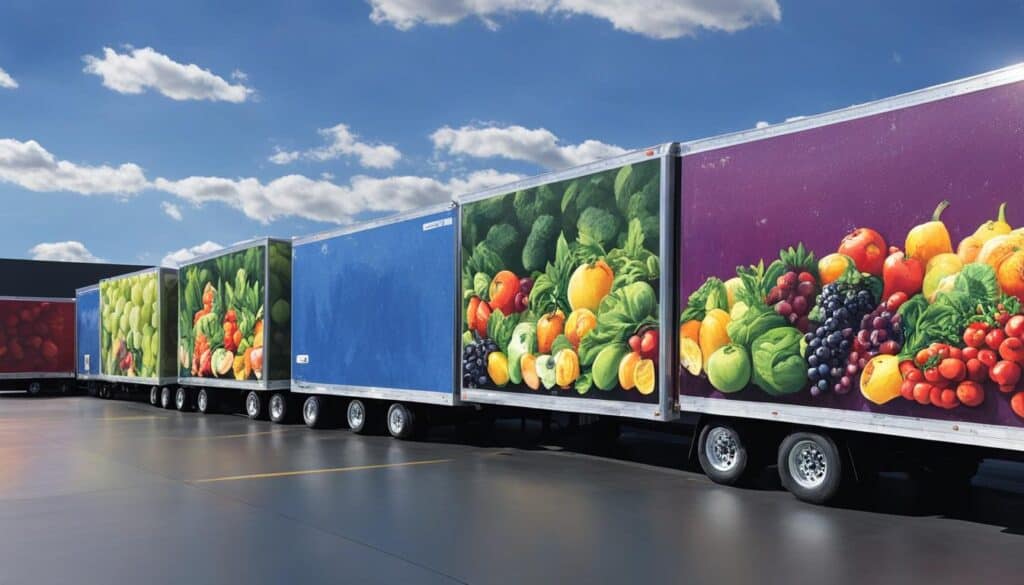
With refrigerated trailers, producers and distributors can safely transport fresh fruits and vegetables to their intended destinations while maintaining their quality and freshness. These trailers provide the necessary temperature and humidity control, protecting the produce against spoilage and ensuring that it arrives in optimal condition for consumers to enjoy.
Finding the Optimal Reefer Temperature for Fruits and Vegetables
When it comes to shipping fresh fruits and vegetables, maintaining the optimal reefer temperature is of utmost importance. The proper temperature range for fresh produce is between 32 and 45 degrees Fahrenheit. This temperature range serves multiple purposes:
- Preventing bacteria growth: By keeping the reefer temperature within this range, we create an environment that inhibits the growth of bacteria. Bacteria growth can lead to spoilage and the loss of the produce.
- Ensuring proper ripening: The temperature range of 32 to 45 degrees Fahrenheit allows fruits and vegetables to ripen at an optimal pace. This ensures that the produce reaches its peak flavor and nutritional value.
- Preserving freshness: By understanding the reefer temperature requirements, we can slow down bacterial growth and extend the freshness of the fruits and vegetables during the shipping process.
By maintaining the optimal reefer temperature, we can prevent bacteria growth, ensure proper ripening, and preserve the freshness of the fruits and vegetables throughout the shipping journey.
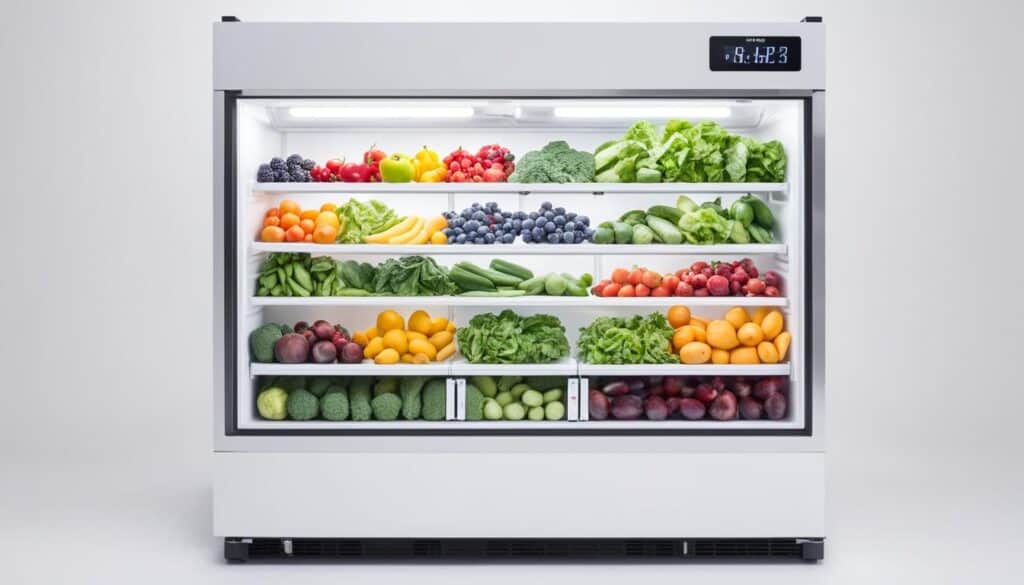
| Temperature Range (in Fahrenheit) | Impact on Fresh Produce |
|---|---|
| Below 32 | Freezing temperatures can damage the produce, leading to texture changes and loss of flavor. |
| 32 – 45 | Optimal temperature range for maintaining freshness, preventing bacteria growth, and ensuring proper ripening. |
| Above 45 | Warmer temperatures can speed up ripening, causing produce to spoil more quickly. |
Understanding the reefer temperature requirements is crucial for effectively shipping fresh fruits and vegetables and preserving their quality until they reach their destination.
Preparing Fresh Fruits and Vegetables for Shipping
When it comes to shipping fresh fruits and vegetables, proper preparation is key to ensuring their quality and freshness upon arrival. Here are some essential steps to take before shipping your produce:
1. Washing Produce Before Shipping
To remove any dirt or debris and maintain cleanliness, it is crucial to wash fresh fruits and vegetables before packaging them for shipping. This step helps to ensure that the produce is free from contaminants and ready for consumption.
2. Grouping Produce for Ventilation
Proper ventilation is vital for preventing the build-up of moisture and maintaining the optimal condition of the produce during shipping. By grouping similar types of fruits and vegetables together, you promote airflow and reduce the risk of spoilage.
3. Careful Loading of Produce
During the loading process, it is important to handle the produce with care to avoid bruising or damage. Gentle handling minimizes the risk of physical injuries, ensuring that your fruits and vegetables arrive in optimal condition.
4. Selecting the Right Shipping Method
The choice of shipping method depends on various factors such as distance, time-sensitivity, and specific produce requirements. Whether you opt for truck, train, or ship transportation, selecting the appropriate shipping method ensures that your shipment reaches its destination efficiently and without compromising quality.
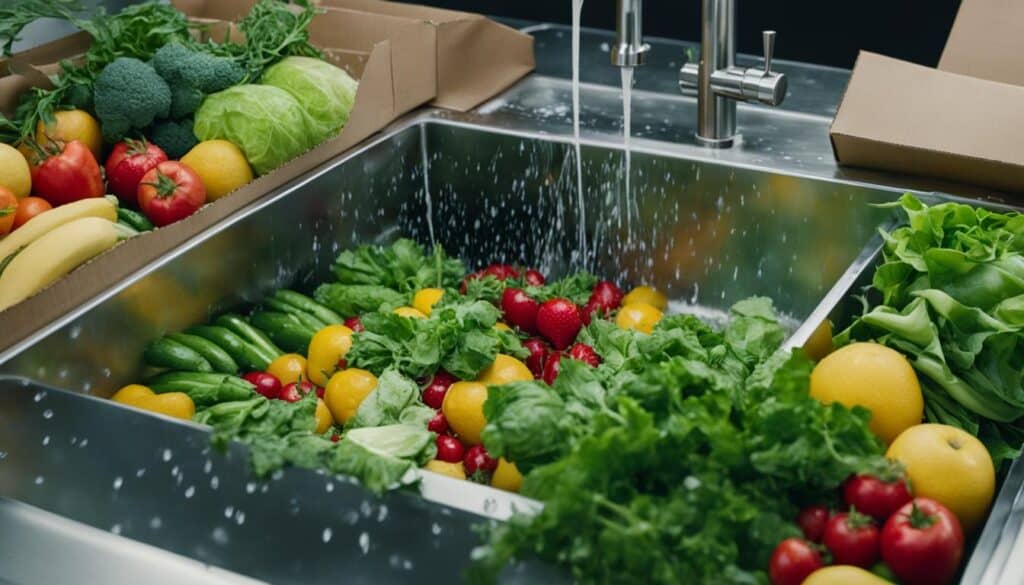
| Shipping Method | Advantages |
|---|---|
| Truck | – Offers flexibility and direct delivery to specific locations. – Provides temperature control options. – Suitable for short to medium-range shipments. |
| Train | – Cost-effective for long-distance shipments. – Environmentally friendly option. – Limited temperature control. |
| Ship | – Ideal for international shipments. – Large storage capacity for bulk produce. – Requires longer transit times. |
By following these steps and selecting the right shipping method, you can ensure that your fresh fruits and vegetables are well-prepared for their journey and arrive in excellent condition.
Choosing the Right Fresh Produce Packaging
The choice of fresh produce packaging plays a critical role in preserving the freshness and integrity of fruits and vegetables during shipping. When selecting packaging, several considerations should be taken into account to ensure optimal results.
Preserving Freshness and Quality
One of the primary considerations when choosing fresh produce packaging is its ability to preserve the freshness and quality of the fruits and vegetables. The packaging should provide adequate protection against external factors that can accelerate spoilage, such as temperature changes, humidity, and physical damage.
Environment and Storage Conditions
The environment where the produce will be stored, both during shipping and at its destination, should also be considered when selecting packaging. For example, if the produce will be exposed to high temperatures, it is essential to choose packaging that can maintain a cool and controlled environment to prevent heat spoilage.
Durability and Shelf Life Extension
The durability of the packaging is another crucial factor to consider. The packaging should be sturdy enough to withstand the rigors of shipping and handling without compromising the fruits and vegetables inside. Additionally, certain packaging materials and designs can help extend the shelf life of produce by providing a protective barrier against external elements.
Convenience in Product Containment and Handling
When choosing fresh produce packaging, it is important to consider the convenience of product containment and handling. Packaging that allows for easy loading and unloading, efficient stacking, and proper ventilation can streamline logistics and minimize handling-related damage.
Visual Appeal and Ease of Opening
Visually appealing packaging can enhance the overall presentation of fresh produce and attract customers. Additionally, it is crucial to choose packaging that is easy to open without compromising the integrity of the fruits and vegetables. Packaging with user-friendly features, such as resealable options, can also contribute to customer satisfaction.
Sustainability Efforts
As sustainability becomes increasingly important, opting for recyclable or compostable packaging can support environmental initiatives. Choosing packaging materials that have a minimal impact on the environment can help reduce waste and promote a more sustainable approach to packaging fresh produce.
By carefully considering these factors, you can select the right packaging for fresh produce that effectively protects and preserves the fruits and vegetables during shipping, ensuring that they reach their destination in peak condition.
Selecting Durable Packaging to Extend Shelf Life and Reduce Waste
When it comes to shipping fresh produce, selecting durable packaging is essential to ensure the longevity of your fruits and vegetables. By using packaging that offers superior protection, you can extend the shelf life of your products and minimize waste. Here are some options to consider:
Flexible Pouches for Freshness
Flexible pouches are an excellent choice for packaging fresh produce. These pouches provide a barrier against moisture, light, and oxygen, which helps to maintain the freshness of fruits and vegetables. The flexible nature of the pouches allows for efficient use of space, reducing shipping weight and costs. Furthermore, the lightweight design minimizes the environmental impact by reducing packaging waste and transportation emissions.
Corrugated Boxes for Shipping
Corrugated boxes are another durable option for shipping fresh fruits and vegetables. These boxes are made of sturdy, layered cardboard, providing excellent protection during transportation. The corrugated design offers impact resistance, preventing product damage while in transit. They are also stackable, making storage and handling more efficient.
By choosing durable packaging, you can safeguard your produce against potential damage that may occur during shipping. This not only helps to maintain the quality and freshness of your fruits and vegetables but also reduces waste, contributing to a more sustainable supply chain.
| Packaging Type | Advantages |
|---|---|
| Flexible Pouches | Superior protection |
| Corrugated Boxes | Sturdy and stackable |
Considering Product Containment for Convenience and Freshness
When it comes to shipping and storing fresh produce, product containment is essential for ensuring convenience and freshness. By utilizing containers with multiple compartments, we can simplify the process of carrying and preparing the produce for sale, eliminating the need for repackaging. This not only saves time and effort but also minimizes the risk of damage to the produce during handling.
Proper containment plays a vital role in keeping the produce hydrated and visually presentable to customers. By choosing packaging that fits the produce well, we can prevent unnecessary movement and minimize the chances of bruising or damage. It is important to utilize containers that offer secure closures to maintain the integrity of the produce throughout the shipping process.
“Containers with multiple compartments simplify the process of carrying and preparing fresh produce.”
Furthermore, utilizing product containment that is specifically designed for fresh produce allows for optimal storage and preparation convenience. These containers are designed to cater to the unique needs of fruits and vegetables, providing the necessary ventilation and protection to keep them at their best for a longer period.
By selecting packaging that maximizes product containment and minimizes wasted space, we not only ensure the convenience of carrying and preparing fresh produce but also contribute to reducing packaging waste.
Benefits of Proper Product Containment:
- Convenience in carrying and preparing fresh produce
- Prevention of damage to the produce during handling
- Hydration and visual appeal of the produce
- Optimal storage and preparation convenience
- Minimization of packaging waste
Overall, product containment is an essential aspect of shipping and storing fresh produce. By choosing the right packaging that offers convenience, protection, and minimal wasted space, we can ensure that our fresh fruits and vegetables arrive at their destination in excellent condition, ready for consumption.
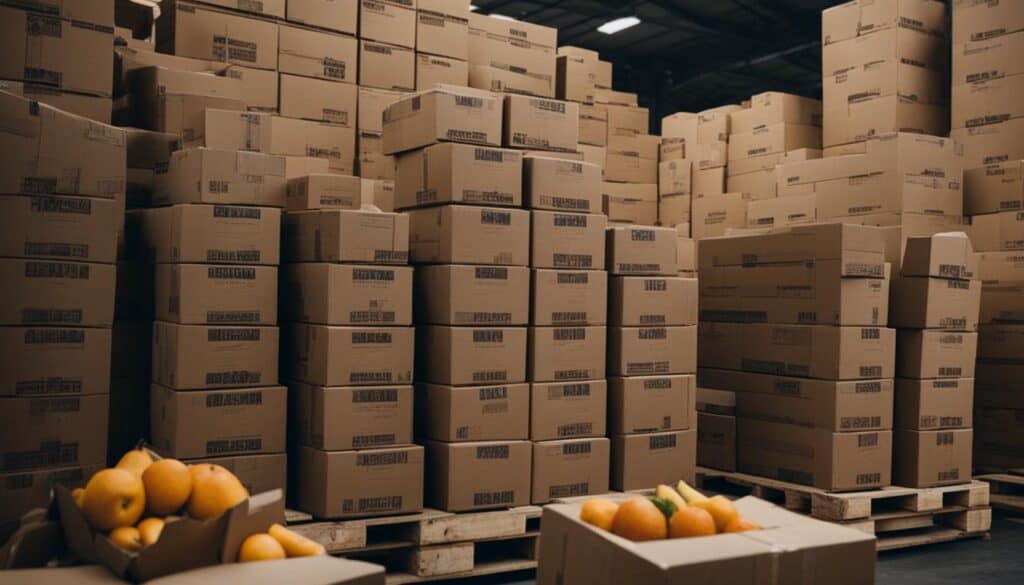
| Benefits of Proper Product Containment | Benefits |
|---|---|
| Convenience in carrying and preparing fresh produce | Easy and efficient handling |
| Prevention of damage to the produce during handling | Minimizes bruising and spoilage |
| Hydration and visual appeal of the produce | Keeps the produce fresh and visually appealing |
| Optimal storage and preparation convenience | Saves time and effort |
| Minimization of packaging waste | Contributes to sustainability |
Emphasizing Ease of Use and Branding in Fresh Produce Packaging
Fresh produce packaging plays a vital role in enhancing the customer experience. It should be designed with ease of use and convenience in mind, whether customers are purchasing in-store or receiving a shipment. Easy-to-open packaging ensures a hassle-free experience for customers, eliminating the need for excessive preparation or tools.
Convenience is key in today’s fast-paced world, and packaging that can be opened quickly and easily saves valuable time for both customers and retailers. Whether it’s a busy shopper in a grocery store or a consumer unboxing a home delivery, convenient packaging enhances the overall satisfaction of the purchase.
Appealing packaging design is another crucial aspect to consider. A well-designed package that catches the eye and showcases the freshness and quality of the produce can instantly attract customers. Visual appeal and modern branding create a positive impression, helping to build trust and loyalty.
“Convenience is key in today’s fast-paced world, and packaging that can be opened quickly and easily saves valuable time for both customers and retailers.”
In the competitive fresh produce market, branding plays a significant role in setting products apart. By incorporating branding elements into the packaging design, such as logos, colors, and taglines, companies can reinforce their brand identity and create a recognizable presence in the market. This branding not only differentiates products from competitors but also helps to build brand loyalty among consumers.
Overall, when it comes to fresh produce packaging, the focus should be on creating packaging that is easy to open, convenient for customers, visually appealing, and aligned with the brand’s identity. By paying attention to these factors, companies can provide a seamless and enjoyable experience for their customers, ultimately driving customer satisfaction and loyalty.
| Benefits of Emphasizing Ease of Use and Branding in Fresh Produce Packaging |
|---|
| Enhanced customer satisfaction and convenience |
| Improved brand recognition and loyalty |
| Increased perceived value of the produce |
| Competitive advantage in the market |
| Opportunity for effective marketing and communication |
Related Articles:
- Packaging Innovations: Redefining the Future of Fresh Produce
- Branding Strategies: Making Your Fresh Produce Stand Out
- The Impact of Convenience on the Customer Experience
Conclusion
In conclusion, shipping fresh fruits and vegetables requires careful consideration of several key factors. By following these tips, you can ensure that your produce arrives in excellent condition, ready for consumption.
First and foremost, choosing the right shipping company is crucial. Look for a reliable company that offers refrigerated shipping services to maintain the freshness of your fruits and vegetables throughout the journey.
Temperature control is vital to prevent spoilage. Using refrigerated trailers, known as reefers, allows you to maintain the optimal reefer temperature range of 32 to 45 degrees Fahrenheit, ensuring that your produce stays fresh and nutritious.
Proper packaging is also essential. Pack your fruits and vegetables in clean, sturdy boxes or plastic crates with sufficient padding to protect them from shifting and bruising during transit. This will help to minimize damage and maintain their quality.
Lastly, don’t forget about branding and convenience. Choose packaging that is easy to open and visually appealing, aligning with your brand identity. Consider product containment for storage convenience and select durable packaging materials that extend the shelf life of your produce, reducing waste.
By following these fresh fruit shipping tips and key points on shipping fresh produce, you are well on your way to efficient fruit shipping. With careful attention to packaging, temperature control, and efficient shipping methods, you can ensure that your fruits and vegetables arrive at their destination in excellent condition, ready to be enjoyed by customers. Happy shipping!
FAQ
How can I ship fresh fruits and vegetables?
To ship fresh fruits and vegetables, it is important to use a reliable shipping company that offers refrigerated shipping services. The produce should be packed in clean, sturdy boxes or plastic crates with plenty of padding to prevent bruising. The packaging should also prevent shifting during shipping to avoid damage.
What are the challenges when shipping fresh produce?
Heat and bruising are common challenges when shipping fresh produce. It is crucial to have a cool, temperature-controlled environment during shipping and use proper packaging to protect the fruits and vegetables.
What is the optimal reefer temperature for fruits and vegetables?
The optimal reefer temperature for fruits and vegetables is between 32 and 45 degrees Fahrenheit. This temperature range prevents the growth of bacteria and allows for the proper ripening of produce, ensuring peak flavor and nutritional value.
How should I prepare fresh fruits and vegetables for shipping?
Before shipping fresh fruits and vegetables, it is important to wash them thoroughly to remove any dirt or debris. Grouping the produce allows for proper ventilation during shipping. Careful loading should be done to prevent damage to the produce. Selecting the right shipping method, whether by truck, train, or ship, depends on the specific needs and distance of the shipment.
What should I consider when choosing fresh produce packaging?
When choosing fresh produce packaging, factors to consider include the environment where the produce will be stored, the durability and shelf life extension offered by the packaging, and the convenience of product containment and handling. Opting for recyclable or compostable packaging supports sustainability efforts.
How can I reduce waste and extend the shelf life of fresh produce?
Choosing durable packaging for shipping produce helps to extend its shelf life and reduce waste. Flexible pouches offer superior protection and minimize shipping weight. Corrugated boxes are another durable choice for shipping fresh fruits and vegetables. The goal is to select packaging that ensures freshness, minimal product damage, and efficient handling and storage.
How can I ensure convenient product containment for fresh produce?
Proper product containment helps to keep fresh produce hydrated and visually presentable to customers. Containers with multiple compartments make it easier to carry and prepare the produce for sale without the need for repackaging. It is important to choose packaging that fits the produce well, with minimal wasted space.
What should I consider in fresh produce packaging for ease of use and branding?
Fresh produce packaging should be easy to open without requiring much preparation. Packaging that can be opened quickly and easily enhances the customer experience. It is important to consider the ease of use and convenience for consumers, whether they are purchasing in-store or receiving a shipment. Attention should also be given to the packaging’s branding and sales appeal, aligning it with the overall brand identity.
What are some key tips for efficient fruit shipping?
Shipping fresh fruits and vegetables requires careful attention to packaging, temperature control, and efficient shipping methods. Choosing the right shipping company, using refrigerated trailers, and considering the optimal reefer temperature are all crucial steps. Properly preparing the produce for shipping, selecting durable and convenient packaging, and focusing on branding and ease of use are also important factors. By following these tips, you can ensure that your fresh fruits and vegetables arrive in excellent condition, ready for consumption.

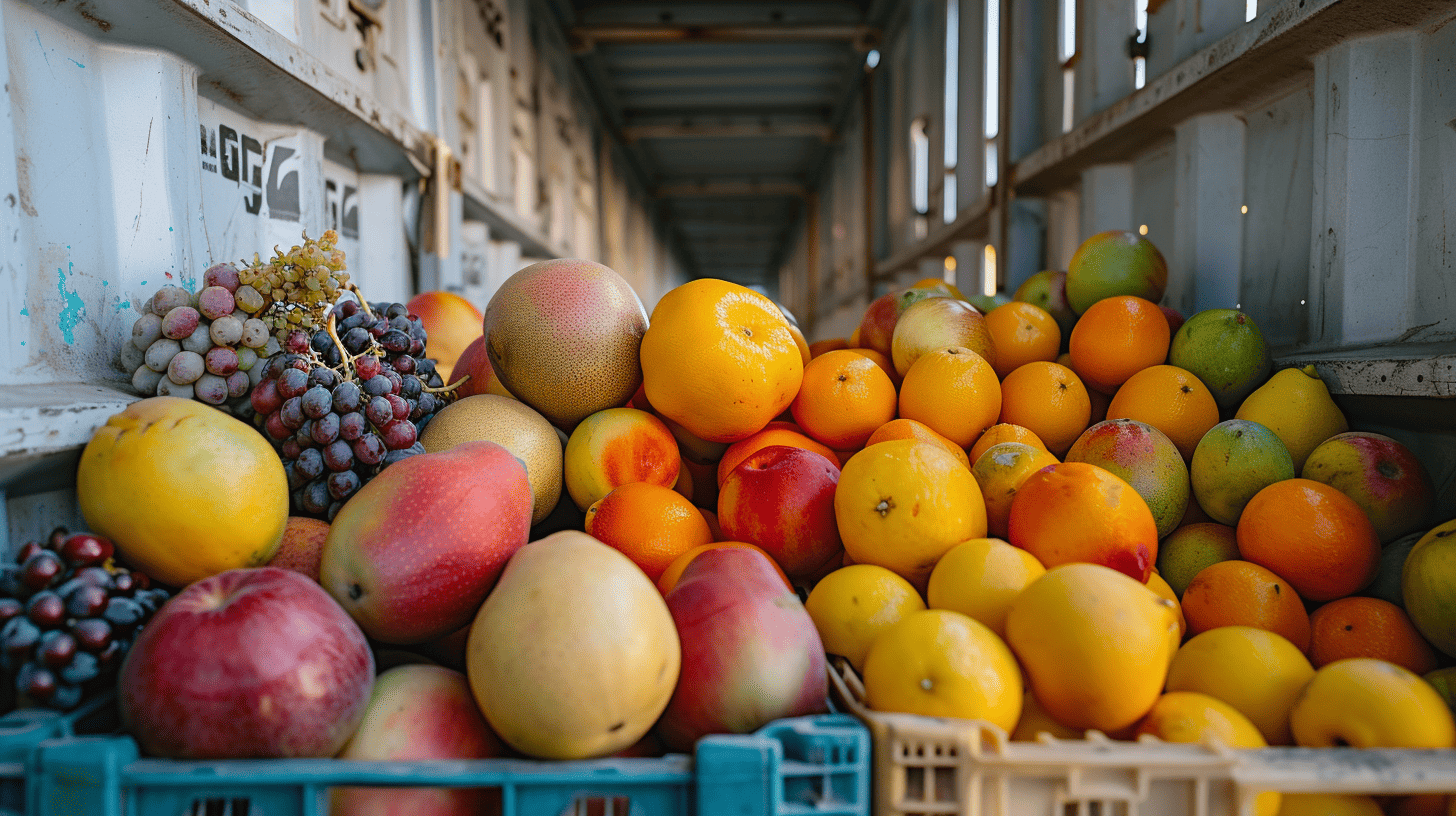



Leave a Reply